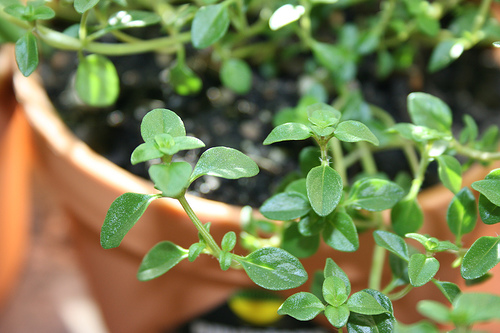Thyme is a delightful culinary herb that enhances soups, salad dressings, casseroles, scrambled eggs and homemade breads with its subtle flavor. Learning how to grow thyme indoors in winter is a convenient and easy way to keep enjoying this delicious herb all year long. If you’d like to give growing thyme indoors a try, here are some growing and serving tips you’ll want to consider.
 Photo of thyme via mezuni/Flickr Creative Commons
Photo of thyme via mezuni/Flickr Creative Commons
Tips on how to grow thyme indoors
- This Mediterranean herb grows best with lots of bright light and average room temperatures of 60 to 75 degrees F. You’ll want to give your thyme plant at least 4 hours of sunlight. Typically south or southwest facing windows are best, although east and west facing windows work well too.
- If you don’t have enough natural light indoors, you can grow thyme under fluorescent lights. Just keep the light on 14 hours a day, about 6 inches above the plant. Make sure your thyme plant is located away from cold windows or heater vents, which could kill the foliage.
- Drought-tolerant thyme should be watered when the top inch of the soil is dried out. Water thoroughly, and make sure the plant container has excellent drainage. Never let your thyme plant sit in water that has collected in the saucer.
- Feed your indoor thyme plant monthly with an organic herb fertilizer. Stop fertilizing the plant in winter, as there is little growth during this time of year.
- If you want to replant your thyme before you bring it indoors for the winter, select a soil that is sandy and well-drained. Many experts recommend a cactus soil mix for excellent drainage. Others like an all-purpose potting soil, made with one-third perlite or sand.
- Experiment with different thyme varieties, from the common Thymus vulgaris to the lemony hybrid T. x citriodorus and lavender-scented thyme Thymus thracicus. There is also a coconut thyme Thymus pulegioides coccineus, which doesn’t taste or smell like coconut, but it flowers a lot. Thymus herba barona — known as caraway thyme — actually smells like caraway seeds.
 Harvested thyme photo via Teresa O’Connor
Harvested thyme photo via Teresa O’Connor
Tips for harvesting thyme
- Growing thyme indoors means you can harvest this aromatic herb whenever you want. Snip the foliage as needed, but try to leave several inches of stem on the plant. Harvest a bit more sparingly during the winter, when the growth has slowed down. Use the harvested pieces right away or refrigerate them until ready to use.
- Thyme is one of the most widely used herbs in the culinary arts. Not surprisingly, thyme is one of my favorite herbs for meals and herbal teas.
- To eat thyme, simply slide your fingers down the stem to dislodge the herb’s leaves. Then crumble the aromatic leaves gently, before adding to your dish. Thyme mixes well with many flavors, including rosemary, lavender, parsley and sage. I especially like thyme with lemons on roasted chicken. The herb is an essential ingredient in the French Herbes de Provence flavor mix.
- If you want thyme to last longer, dry the little stems on a fine screen. Or hang them upside down in a dry, cool, dark place. When they are completely dry, store the leaves in glass jars tightly closed and stored somewhere dark.
- You can also freeze thyme. I like to take the little leaves and mix them with a veggie stock or olive oil. Then I freeze these herbal treats in an ice cube tray, which I eventually transfer into a freezer bag for storage. To use these herbs in a soup or casserole, simply pop out a cube and add the herbs while cooking. Thyme adds a wonderful subtle flavor when cooked gently in your meals.
- From flavored butters to thyme-infused ice cubes, there are lots of fun ways to preserve thyme and other herbs for cold-weather meals.
Once you start cooking regularly with this popular herb, you’ll wonder how you ever lived without it. You definitely want to make time to grow thyme in your home this winter.

Share tips, start a discussion or ask one of our experts or other students a question.
No Responses to “Enjoy Fresh Herbs All Winter Long: How to Grow Thyme Indoors”